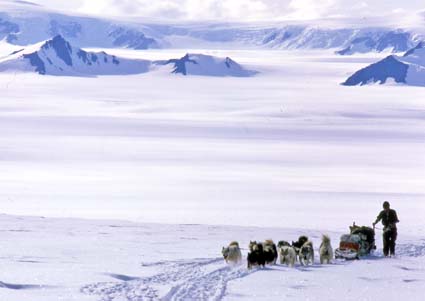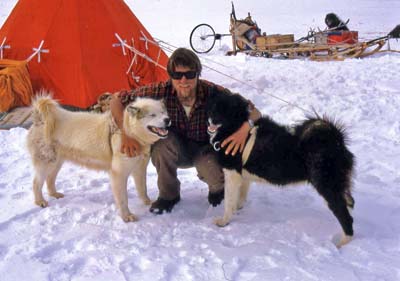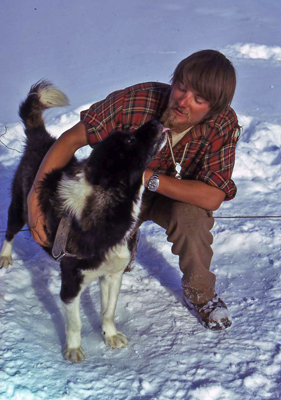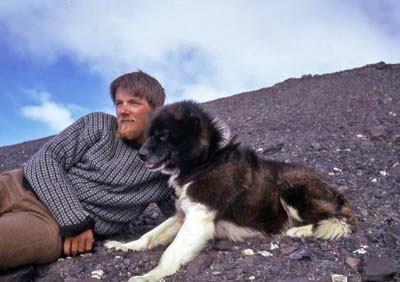From the Editor: Welcome to My World
Iqaluit Asphalt Plant Update
From the NFB Film Files
Living and Dying with Black Bears
Film Review: Okpik’s Dream
Canadian Inuit Dogs I have Owned, Raised and Trained:
a photo essay; Part 1
A BAS Doggy Man Reminisces:
Chris Edwards’ interview on Houndsounds
Special Screening of Inuk in Vermont;
new general release date given
IMHO: Where We Stand
Navigating This Site
Index of articles by subject
Index of back issues by volume number
Search The Fan Hitch
Articles to download and print
Ordering Ken MacRury's Thesis
Our comprehensive list of resources
Defining the Inuit Dog
Talk to The Fan Hitch
The Fan Hitch home page
Editor: Sue Hamilton
Webmaster: Mark Hamilton
The Fan Hitch, Journal
of the Inuit Sled Dog, is published four
times a year. It is available at no cost
online at: https://thefanhitch.org.
The Fan Hitch welcomes your letters, stories, comments and suggestions. The editorial staff reserves the right to edit submissions used for publication.
Contents of The Fan Hitch are protected by international copyright laws. No photo, drawing or text may be reproduced in any form without written consent. Webmasters please note: written consent is necessary before linking this site to yours! Please forward requests to Sue Hamilton, 55 Town Line Rd., Harwinton, Connecticut 06791, USA or mail@thefanhitch.org.
This site is dedicated to the Inuit Dog as well as related Inuit culture and traditions. It is also home to The Fan Hitch, Journal of the Inuit Sled Dog.
The Fan Hitch welcomes your letters, stories, comments and suggestions. The editorial staff reserves the right to edit submissions used for publication.
Contents of The Fan Hitch are protected by international copyright laws. No photo, drawing or text may be reproduced in any form without written consent. Webmasters please note: written consent is necessary before linking this site to yours! Please forward requests to Sue Hamilton, 55 Town Line Rd., Harwinton, Connecticut 06791, USA or mail@thefanhitch.org.
This site is dedicated to the Inuit Dog as well as related Inuit culture and traditions. It is also home to The Fan Hitch, Journal of the Inuit Sled Dog.

Alexander Island 1974 photo: Edwards
A BAS Doggy Man reminisces:
Chris Edwards' interview on Houndsounds
Intro
Huskies are exceptional dogs who ran expeditions across the north and south poles for over a century. Chris Edwards, a geologist used huskies in Antarctica in the ‘70s until the British Antarctic Survey changed to using mechanised vehicles with tragic consequences for the dogs. In “Huskyman”, Chris tells his story to Kate Bland in his home in Inverurie near Aberdeen in Scotland.
Huskyman’s story
My name is Chris Edwards, I live in Aberdeenshire. I started my scientific career as a geologist with the British Antarctic Survey back in the seventies, having graduated from Glasgow University, and then just spent two-and-a-half years in Antarctica. And I didn’t have any concept about how you get from one part of Antarctica to another. Most peoples’ idea of Antarctica is a big, flat, white sheet of ice, and that is in fact not the case in the parts which we were visiting, the Antarctica Peninsula particularly. And nobody teaches you how to drive dogs. You arrive on base and suddenly they say well there’s your nine dogs, go and do a good summer’s work. When I say dogs I mean huskies and we’re talking about thirty to forty kilos of fairly sizeable dog.
The base I was on was a small island about a half-mile long, a quarter-mile wide, accessible obviously from the sea from the point of view of getting stores and so on from the ship. The dogs were kept somewhat away from the base primarily from the noise point of view. You didn’t want dogs right outside the house howling and so on. Huskies don’t bark. They howl and it’s a wonderful evocative sound of Antarctica generally.
I’ve seen photographs of Captain Scott’s expedition where they build individual kennels for each husky. A husky would rather stand or sleep on top of the kennel rather than in the kennel. Huskies are designed to be outside. So the dogs were actually kept on clean bits of snow which happened to be on the surface of a glacier just adjacent to the island. We could get up from the island up a snow ramp onto the surface of the glacier. There were no crevasses, or there were tiny little crevasses, but nothing dangerous. Periodically we would bring dogs down to the house for a whole variety of reasons, more for entertainment more than anything else. And certainly if we had pups available you’d bring them into the house and that was always great fun you know just to see pups marauding around. And of course they would get hot because they were not designed for indoor heated accommodation. They would just go to sleep eventually.
While we were on base, we would be feeding dogs seal meat. And the seal were acquired, if you like, or shot while the ships were down during the summer sometime, and for a hundred and fifty huskies we were having to shoot about five hundred seals. Now these were crabeater seals or Weddell seals of which, as far as crabeater seals were concerned, were estimated to be about forty million. But away from base you couldn’t carry lumps of seal meat so we had a preparation a compressed block of meat and cereal and fat and we would feed the dogs these one-pound blocks. I think the regime was one one day, one the next day and two the third day. And even on that diet they actually gained weight sometimes while were out working in the field and that was working eight hours a day, so that was quite a good preparation.
During the winter where we were, about 68 degrees south, it was too dark in the winter. We would have only about two hours of twilight in the middle of the day. But in the spring and the autumn we would go away for trips away from base in a relatively local area about thirty or forty miles from base. But during the summer we left base at the end of August and didn't come back to base until the middle of February or thereabouts. So you were away from base for about five months and that’s living in a tent with one other person. Each of us had nine dogs; two teams, two men, one tent and that was us.

Chris with Sue (l) and Isolde (r) photo: Edwards
Each dog had its own individual harness made of a cotton webbing material which was called lampwick. So each driver had to make a harness to fit each individual dog. So you would make up a rough harness and then you would take it to the dog and making sure they were all snug and the harness fits correctly because particularly out in the field if you were out in the field for three or four months, the dog might loose weight and you might have to adjust the fitting of the harness so it fits better. And the neck loop goes over the head and then the two leg loops. So you’re very close to the dog. You’re picking up the front paws. It’s also an opportunity to see that dogs are not getting injured or not suffering in any way because that’s your lifeline, they’re your friends. You have to look after them and they will look after you.
The process in the morning would be out the tent, get the harnesses sorted out, harness up each dog. The dog would be led over to the trace and clipped on. So once you‘ve got your nine dogs – there usually was nine dogs as far as we were concerned – clipped onto the trace then you would take out the anchor, if you like, from the front of the trace and that gets all the dogs excited and you hope you make it back to the sledge before the dogs are revving away and pull the anchor out of the sledge before you were actually ready.
The teams were mixed. Inevitably you couldn’t have all bitches or all dogs. In general, and I hate to say it, sometimes the bitches were more intelligent than the dogs and they also tended to be lighter so you tend to put the lighter dogs towards the front of the team and the heavy dogs, the brawn if you like, near the sledge so they could give an awful lot more power just to maybe unstick a sledge or something like that. So the lighter, perhaps more intelligent dogs were put forward and that then gave you some direction control. There’s no steering wheel on the sledge. It’s all done by voice commands and so you’d have to have a dog that would respond to very simple commands, basically left and right, and you had to identify the dogs so that they were responding to those commands and then you would tend to move those forward. But the heavier, more powerful dogs tended to be back towards the sledge.
Every dog is an individual and you could pick up traits. I mean the whole idea was that the dogs would be harnessed and pulling the sledge. But some dogs were less inclined to pull too much and you’d have to recognize that and you would maybe chastise them for it and shout at them. You could tell the dogs that were putting their little heart and souls into it and the ones that weren’t quite pulling to the best of their ability and in that instance you would maybe put them back near to the sledge.
As long as you were moving fairly frequently the dogs were quite happy. The dogs get bored. Essentially they get bored. Even when you’re traveling, if you think of a dog’s eye level, it’s only a half a metre, a couple of feet somewhere like that above ground level. And so certainly when we were travelling up on the Antarctic Peninsula plateau you’re up at five or six thousand feet, pretty flat and featureless. You might have mountains way, way in the distance, but dogs get bored. There’s nothing to look at particularly and so you have to keep them amused. And you can see when they get bored. The tails start to droop. The whole attitude of the dog changes. And so what you would do to try to stimulate them you’d try to jolly them along by saying, “Oh c’mon, hup, hup, go!” And that might be fine for once or twice but we also resorted to singing silly songs, making funny noises and the dogs would turn around and say, “What you up, Boss? What’s going on?” We could see the ears go up and the tail would go up and they would trot along quite happily.

Big licks from Isolde photo:Edwards
I’ve photographs which I think I probably sent back to my parents just to let them know what I was doing, but obviously some of my favorite dogs as well. We have Andy who is a very classic husky with short, pointed ears and a very curly tail and very, very thick fur. I also have my lead dog, Isolde, which I trained up from a pup to be an extremely good leader even though I say so myself. She was my favourite dog and I used to take her onto the rock when I was going on to geologise. But I had skiis and I could get across the crevasse which always invariably separates the moving ice from the ice that’s fixed to the rock and that is called the “bergschrund”. But I couldn’t carry her across so I used to pick her up and throw her across this relatively small crevasse. But she’s a dog that was weighing thirty to thirty-five kilos so it was not a simple thing to do but she accepted it after I’d done it a couple of times and she realized she wasn’t in any danger by being thrown across. She would scrabble around and I would put my rucksack down, sometimes take my jersey off and while I was away geologizing, mapping and collecting samples and so on she would just go to sleep, otherwise she’d be following me around on the rock. And she was one husky that probably never had much in the way of nails because running on snow of course nails tend not to wear down but on the rock they would be wearing down.
This is the general dog report for 1974-1975. That was really towards the end of the British Antarctic Survey using dogs as the prime means of transport. The nature of the science was changing and just before mid-winter we had this telegram down from the office in the UK saying that as of the end of that summer season, so that would be the summer of ‘74/’75, dogs would be effectively phased out and be replaced by mechanical transport. My introduction here to this report says that the news during ’74 was that the base was to be closed and the husky population reduced to four teams, meant the end of large scale dog operations in Antarctica.
Once we got over the shock we then had to decide how was this cull, this removal of all the dogs going to be done and which dogs. Well obviously you would tend to cull the older dogs and leave younger dogs, and of the younger dogs, which ones do you take, do you take the heavier ones or the lighter ones or…all these decisions had to be made. And it was an awful trauma for everybody because you always had your favorite dog. Every driver would have had his favorite dogs and the thought that this was going to be the end in a matter of a few months time…you just had to make the best of it.
I don’t remember all the details, but when I decided, and it was probably me that made the decision, I knew how and when and which dogs had to be done. I then took it upon myself that was going to do everybody else’s dogs. I took it upon myself because I was the doggy man. I would not do my own dogs. Dogs that I had run and had been faithful to me I refused to do that in fact I got my colleague to do it. But what I did ultimately was I had all the dogs I had selected flown to a base where they had no intimate relationship with dogs. They had one dog on base just as a pet dog, but I had something like a hundred and twelve huskies flown to a base where the deed was finally done.
To give them a euthanasia drug would have been possible but it would have taken much, much longer. I think that out of all the hundred and twelve huskies I did, I think only a half a dozen were euthanized and they were done back on the base where the huskies had originated and that was really just to spare everybody the sound of a gunshot, otherwise it was a .45 revolver. It was all done in a very bloody afternoon.
People say well why didn’t you bring them back to the UK. There was never any question what would you do with a hundred and twelve huskies. They were not domestic dogs. You couldn’t bring them back and give them away to people in the UK.
Come 1993 all the Antarctic Treaty countries made a decision that in Antarctica, as a contrary to science, there should be no non-indigenous animals or plants except man, of course the biggest polluter of all. The thinking at the time was that dogs would pass on diseases, potentially phocine distemper to seals, but in reality it was actually diseases were coming the other way. The vet that we had down, he was looking at a disease which we think had probably come from seals onto dogs’ pads.
This is the dog report which I wrote just after the cull of all the dogs and these were the list of the forty-two dogs which I left as this nucleus potentially of breeding stock which includes about fifteen or so bitches and thirty or so dogs. And Isolde is one of the bitches which I left. She was born in 1971. She survived after I left until 1982 and then she was culled as being old. By that time she was eleven years-old. And that applies to most of these dogs. They would have gone on until about eleven. Huskies get arthritis and they become less and less able to do what we would like them to do.
The last day I was there I spent most of the time just with her by herself. I took her off the span and just went a-walk away from base and missively sat down quietly and thought about all the good times we had. I was never going to see her again. It was a love story, really. And I have photographs of her on the wall, stuff on the wall, just of her staring out towards the camera. And, yeah, it’s fantastic.

Chris and Isolde reminiscing photo: Edwards
Ed.: British Antarctic Survey (BAS) doggy man, Chris Edwards, was a geologist stationed on Stonington Island on the Antarctic Peninsula 1974-1975. He recorded this interview of his recollections for Houndsounds earlier this year. The Fan Hitch is very grateful to Kate Bland of Houndsounds for granting permission to transcribe it (as spoken) and to publish it here. Readers who have an audio player in their internet browser can hear Chris’ audio interview at Houndsounds. And of course The Fan Hitch thanks Chris for his blessing to publish the transcription of his interview and for sharing his lovely photos.